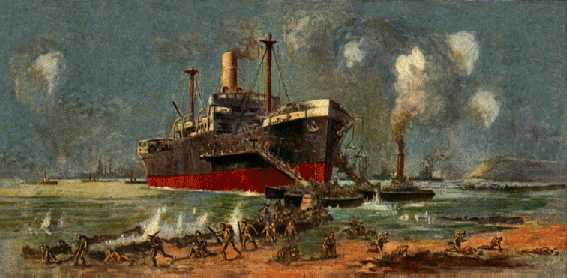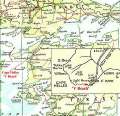Gallipoli/The River Clyde Landing
 | River Clyde by Charles Dixon |
Images and text contributed by
ø James F. O'Sullivan
e-mail: finbarr@netspace.net.au
|
Gallipoli/The River Clyde Landing The scheme for landing the 29th Division on the Gallipoli Peninsula at Cape Helles was that five beaches designated 'S', 'V', 'W', 'X' and 'Y' were to be attacked simultaneously. Some of the division were to be landed from the River Clyde. The River Clyde was a collier of some 2000 tons. The innovative idea of converting this vessel into a 'Horse of Troy' came from a Royal Naval Officer, Commander Edward Unwin. The collier was to be filled with troops and run aground at 'V' Beach. To expedite the safe disembarkation of troops, holes were cut through the steel plates in her sides; troops could emerge on to gangways supported by ropes which ran along the sides towards the bows of the vessel from each side. These gangways then led down to two barges which were to form a gangway to shore. 'V' Beach Map The River Clyde could hold about 2,100 troops together with the necessary crew, and she had eight machine guns mounted on her decks. The barges which would form the gangway to shore were to be towed alongside the vessel, and with the impetus of the ship under way, were to shoot forward when the vessel was beached and then manoeuvre into position so that the troops could run along them to shore and so land quickly, form up, and develop the attack. Troops were staged at Lemnos. On 23-Apr-1915 at approximately 17.00 hours, the transport Caledonia left Lemnos with troops for Tenedos where final dispositions were made before the 'V' Beach landings. Steaming slowly all night with lights out, Tenedos about forty miles away was reached at 07.00 hours on 24-Apr-1915. At 15.15 hours orders were received to embark on the River Clyde. By 19.30 hours the embarkation was complete.
All the troops aboard were under the command of Lieut.-Colonel Carrington Smith, Hampshire Regiment. The landing at 'V' Beach was to be made by the Royal Munster Fusiliers and the Royal Dublin Fusiliers. The supporting ships were H.M.S. Albion, Lord Nelson, Dublin and Cornwallis. Two hundred rounds of ammunition and three days iron rations were carried by each soldier, with greatcoats and waterproof sheet in pack. Cocoa was to be issued to the troops just before dawn. At 01.00 hours on 25-Apr-1915, the River Clyde left her moorings and slowly steamed towards her objective. At 05.00 hours the naval bombardment of the Turkish defences commenced, all troops were ordered below decks. As the River Clyde steamed slowly in, the sun was facing her and it was very difficult to see the shore on account of smoke from the bursting shells. The ship headed for the beach and was run ashore about 06.25 hours, and grounded without the slightest jar in water that was out of the men's depth. And there she remained throughout the whole of the campaign. The barges which were to have formed the gangway to shore from the ship, instead of going straight ahead as was expected, went wide of the vessel, but were eventually pulled into position under a hail of machine gun bullets from the defending Turks. The Turks had been shaken but not obliterated by the naval bombardment. The interval between the shelling and the actual landing was a reprieve for them; they had returned to their trenches to take up fighting positions once again. After the gangways were made ready the troops instantly responded. However as they disembarked and made a dash for the shore across the gangways they were mown down under a tornado of shot and shell. One of the barges broke away and drifted into deep water, some soldiers jumped over the side in an endeavour to make the shore, however many men sank owing to the weight of their equipment and were drowned. The carnage on 'V' Beach was chilling, dead and wounded lay at the waters edge tinted crimson from their blood. Throughout most of the day the River Clyde was under heavy fire from the Turkish defenders. Some one thousand troops were still on board. By 01.00 hours on the 26th April and under cover of darkness, all troops from the River Clyde had been got ashore and nearly all the collected wounded had been brought back to the vessel for treatment. One of the wounded men was my father L/Corpl Timothy Sullivan, aged 23 years, regimental number 9600, Royal Munster Fusiliers. He was one of the few survivors of this ill-fated landing. He lived to help fight another war.
|


